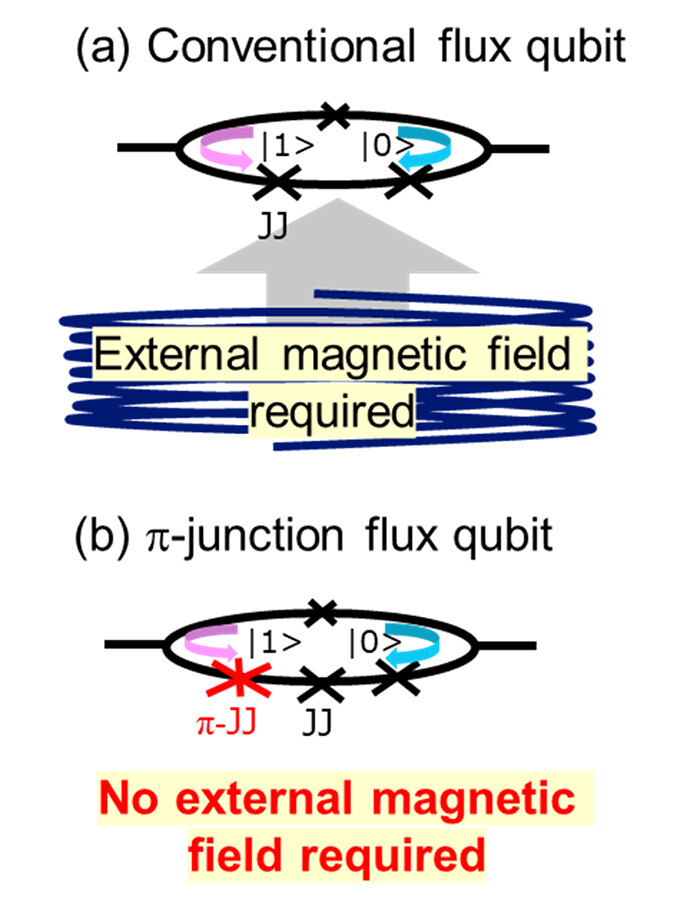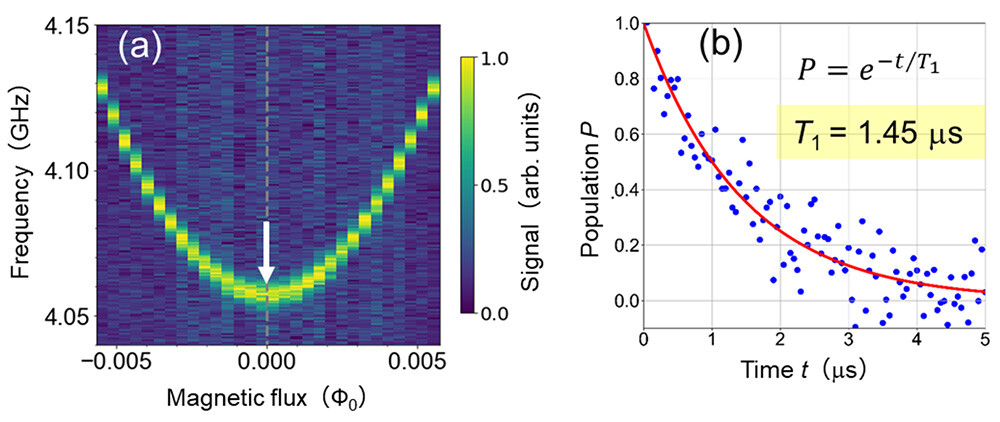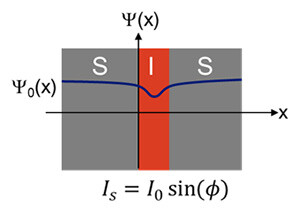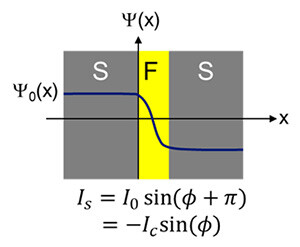Microsoft ends support for Internet Explorer on June 16, 2022.
We recommend using one of the browsers listed below.
- Microsoft Edge(Latest version)
- Mozilla Firefox(Latest version)
- Google Chrome(Latest version)
- Apple Safari(Latest version)
Please contact your browser provider for download and installation instructions.
October 15, 2024
National Institute of Information and Communications Technology
NTT Corporation
Tohoku University
Nagoya University
World's First Superconducting Flux Qubit Operating without Magnetic field
- A significant step towards miniaturizing quantum circuits for quantum computers -
[Highlights]
- Developed a new type of superconducting flux qubit that operates optimally in zero magnetic field without the need for auxiliary circuits such as bulky coils.
- Achieved the best coherence time among superconducting qubits with a ferromagnetic Josephson π-junction.
- Expected to be applied to quantum devices that enable the miniaturization of quantum computers.
[Abstract]
The National Institute of Information and Communications Technology (NICT, President: TOKUDA Hideyuki, Ph.D.), NTT Corporation (NTT, President: Mr. SHIMADA Akira), Tohoku University (President: Dr. TOMINAGA Teiji) and the Tokai National Higher Education and Research System Nagoya University (President: Dr. SUGIYAMA Naoshi) succeeded in developing a new type of superconducting flux qubit*1 that operates in zero magnetic field.
Conventional superconducting flux qubits require an external magnetic field generated by bulky coils or an additional local flux bias line near the qubit. The newly developed superconducting flux qubit using a ferromagnetic Josephson junction*2 (named π-junction*3) demonstrates the realization of a flux qubit operating at zero magnetic field. The qubit lifetime is in the microsecond range, which is the longest among the superconducting qubits with ferromagnetic π-junction. By further improving the ferromagnetic junction material in the future, this π-junction and flux qubit that can operate in zero magnetic field may become essential elements of high-performance quantum devices that are indispensable for quantum computers.
This result was published in the British scientific journal "Communications Materials" on October 11, 2024.
[Background]
-
In the information technology of the future, quantum computers are expected to play a crucial role in various fields, from material and pharmaceutical development to information security. Among the promising technologies, superconducting qubits stand out for their relatively easy control of quantum states. Josephson junctions, which are essential components of superconducting qubits, provide anharmonicity*4 to the circuit, enabling qubit operation. The characteristics of a few representative superconducting qubits are shown in Table 1.
Transmon qubits*5 [1], widely used today for superconducting quantum computers, have low anharmonicity, which may cause problems such as frequency crowding when integrating many qubits.
On the other hand, flux qubits [2, 3], which use three Josephson junctions, have higher anharmonicity and can mitigate frequency crowding problems (See Figure 1(a)). However, flux qubits require external coils to apply half a magnetic flux quantum (Φ0 = 2.07×10-15 Wb) to the superconducting loop for optimal operation, leading to challenges like low-frequency noise from the coils or the need for additional control lines for each qubit, hindering large-scale integration.
To address this, researchers at Tohoku University, led by Prof. Taro Yamashita (then at Nagoya University), proposed incorporating a π-junction into the flux qubit (See Figure 1(b)). This π-junction, which uses a ferromagnetic Josephson junction, generates a 180-degree (π) phase difference without external magnetic fields, allowing the qubit to reach its optimal operating point spontaneously. -
Figure 1 Schematic diagrams of two superconducting flux qubit circuits. The conventional qubit (a) requires an external magnetic field to operate optimally, while the new flux qubit (b), using a π-junction, achieves optimal operation without the need for an external magnetic field.

Table 1. Characteristics of a few representative superconducting qubits

This is expected to reduce external noise, simplify the circuit, and make qubit integration easier.
[Achievements]
In this study, we combined NICT's nitride superconducting qubit technology, based on niobium nitride (NbN) grown on silicon substrates (as reported by NICT press release on September 20, 2021), with the technology for ferromagnetic Josephson devices (as reported by NICT press release on November 15, 2017). This integration allowed us to develop a flux qubit with a π-junction. We successfully demonstrated that this flux qubit with a π-junciton can operate optimally at zero magnetic field and elucidated its coherence properties.
 Figure 2 (a) Optical microscope image of the developed π-junction flux qubit with false color for the clarification. The Josephson junctions (JJ), π-junctions, and via-holes are shown in purple, yellow, and blue, and the circuit diagram on the right shows three Josephson junctions (x, purple) and a π-junction (*, yellow).
Figure 2 (a) Optical microscope image of the developed π-junction flux qubit with false color for the clarification. The Josephson junctions (JJ), π-junctions, and via-holes are shown in purple, yellow, and blue, and the circuit diagram on the right shows three Josephson junctions (x, purple) and a π-junction (*, yellow).
(b) Structure of a Josephson junction made of the all-nitride superconductors.
(c) Structure of a π-junction formed on a niobium nitride (NbN) base electrode.
 Figure 3 (a) Microwave spectroscopy spectrum showing the magnetic field dependence of the transition frequency from the ground state to the excited state of the π-junction flux qubit. The arrow indicates the optimum operating point of the π-junction flux qubit, showing the lowest transition frequency. While the optimum operating point for conventional flux qubits appears at 0.5Φ0, the new flux qubit is characterized by its appearance at zero magnetic field (0Φ0).
Figure 3 (a) Microwave spectroscopy spectrum showing the magnetic field dependence of the transition frequency from the ground state to the excited state of the π-junction flux qubit. The arrow indicates the optimum operating point of the π-junction flux qubit, showing the lowest transition frequency. While the optimum operating point for conventional flux qubits appears at 0.5Φ0, the new flux qubit is characterized by its appearance at zero magnetic field (0Φ0).
(b) Coherence time measurement showing an energy relaxation time T1 = 1.45 µs.
Previous studies include the work of Prof. Alexey Ustinov's research team at the Karlsruhe Institute of Technology (Germany) [4], who reported a coherence time of 4 nanoseconds in a phase qubit*6 composed of Nb/AlOx/Nb Josephson junctions and Nb/CuNi/Nb π-junctions. Additionally, they attempted to introduce a π-junction into a flux qubit, but did not observe quantum coherent qubit operation [5].
In our research, we utilized PdNi, which maintains a more stable π-state than CuNi, to form a π-junction on an NbN electrode. Furthermore, we combined NICT's NbN/AlN/NbN Josephson junction technology with NTT's optimal design for flux qubits in 3D cavity resonators to develop a new type of flux qubit that operates optimally in zero magnetic fields (see Figure 2). Measurements using NTT's long-coherence-time qubit measurement system confirmed that the optimal operating point is at zero magnetic field, with a coherence time of 1.45 microsecond (see Figure 3). This marks a 360-fold improvement in coherence time compared to phase qubits with π-junctions.
However, conventional flux qubits fabricated without a π-junction exhibit an energy relaxation time of 16 microseconds (as reported by NICT on September 20, 2021), indicating that the π-junction of the current NbN/PdNi/NbN structure negatively impacts quantum coherence.
While further improvement in quantum coherence is still needed, this achievement represents the world's first realization of a flux qubit that does not require an external magnetic field and exhibits a coherence time on the order of microseconds. This technology is a crucial step toward miniaturizing and integrating various quantum circuits, including qubits. By eliminating the need for an external magnetic field, it will contribute to simplifying circuits, saving energy, and reducing costs.
[Future prospects]
Looking ahead, we aim to optimize the circuit structure and fabrication process to further extend the coherence time and improve the uniformity of device characteristics, with an eye toward future large-scale integration. Our goal is to develop a new platform for quantum hardware that could surpass the performance of conventional aluminum-based qubits. By improving the materials and structure of the ferromagnetic junction, we hope to develop a π-junction flux qubit with longer coherence time that can operate in zero magnetic field. Such advancements could make it a critical component in various quantum technologies, including quantum computer chips.
<Role of each organization>
- National Institute of Information and Communications Technology:
Research concept, design and fabrication of superconducting flux qubits, evaluation of Josephson junction properties - NTT:
Measurement of superconducting qubits using 3D resonators - Tohoku University, Nagoya University:
Research concept, fabrication of ferromagnetic π-junctions and evaluation of their properties
<Article information>
Journal: Communications Materials
DOI: 10.1038/s43246-024-00659-1
URL: https://doi.org/10.1038/s43246-024-00659-1
Title: Superconducting flux qubit with ferromagnetic Josephson π-junction operating at zero magnetic field
Authors: Sunmi Kim, Leonid V. Abdurakhimov, Duong Pham, Wei Qiu, Hirotaka Terai, Sahel Ashhab, Shiro Saito, Taro Yamashita, and Kouichi Semba
<Related past press releases>
September 20, 2021
All-nitride Superconducting Qubit Made on a Silicon Substrate
https://www.nict.go.jp/en/press/2021/09/20-1.htmlNovember 17, 2017 (Japanese version only)
(NbN-Based Ferromagnetic 0 and π Josephson Junctions)
https://www.nict.go.jp/press/2017/11/15-1.htmlOctober 11, 2016
Stable Molecular State of Photons and Artificial Atom Discovered
https://www.nict.go.jp/en/press/2016/10/11-1.html
This work was partly supported by Japan Science and Technology Agency Core Research for Evolutionary Science and Technology (Grant No. JPMJCR1775), JSPS KAKENHI (JP19H05615), JST ERATO (JPMJER1601), and partially by MEXT Quantum Leap Flagship Programs (JPMXS0120319794 and JPMXS0118068682).
Technical Contact
KIM Sunmi, ASHHAB Sahel, SEMBA Kouichi
Quantum ICT Laboratory
Koganei Frontier Research Center
Advanced ICT Research Institute
National Institute of Information and Communications Technology
E-mail: kimsunmi@nict.go.jp, ashhab@nict.go.jp, semba@nict.go.jp
TERAI Hirotaka
Superconductive ICT Device Laboratory
Kobe Frontier Research Center
Advanced ICT Research Institute
National Institute of Information and Communications Technology
E-mail: terai@nict.go.jp
SAITO Shiro
Physical Science Lab.
NTT Basic Research Laboratories
E-mail: shiro.saito@ntt.com
YAMASHITA Taro
Graduate School of Engineering
Tohoku University
(then at Nagoya University)
E-mail: taro.yamashita.c8@tohoku.ac.jp
Media Contact
Press Office
Public Relations Department
National Institute of Information and Communications Technology
E-mail: publicity@nict.go.jp
PR Office
NTT Science and Core Technology Laboratory Group
NTT Corporation
E-mail: nttrd-pr@ml.ntt.com
Information and Public Relations Office
Graduate School of Engineering
Tohoku University
E-mail: eng-pr@grp.tohoku.ac.jp
<Glossary>
*1Superconducting flux qubit
A type of quantum bit (basic element used in quantum computers to handle quantum information), it is composed of a superconducting loop including a Josephson junction*2. The superposition of the quantum states of |0> and |1> is realized by the persistent current in the superconducting loop induced by a magnetic flux (for example, clockwise current represents |0>, while counterclockwise current represents |1>).
*2Josephson junction
An element (Josephson element) with a structure in which two superconducting electrodes (S) are separated by an extremely thin insulator (I) or a thin film of normal metal. A current (Josephson current IS) with zero electrical resistance (zero voltage) can flow in a Josephson junction because of the tunnel effect between the superconducting electrodes. The magnitude of this Josephson current is determined by the difference (Φ) in the macroscopic phase between the two superconducting electrodes (DC Josephson effect), so conversely, the macroscopic phase between the superconducting electrodes can be controlled by how much current is passed through the Josephson element. Many superconducting devices, including superconducting quantum bits, use macroscopic phase control by this Josephson element as their basic operating principle.

*3π-junction
A π-junction is a special Josephson junction*2 that has a structure in which a ferromagnet (F) is sandwiched between superconductors (S) and is characterized by the fact that when the Josephson current bias is zero, the phase difference is 180 degrees (π), rather than 0 as in a conventional Josephson junction. Due to this phase shift, the Josephson π-junction has the same effect on superconducting circuits as applying a magnetic field equivalent to half a flux quantum.

*4Anharmonicity
The property that the energy difference between the ground state and first excited state of a superconducting quantum bit is different from the energy difference between the first and second excited states. It is quantified by the difference (E12-E01), where E01 is the energy difference between the ground state |0> and the first excited state |1>, and E12 is the energy difference between the first excited state |1> and the next energy level |2>.
*5Transmon qubit
A type of superconducting quantum bit. It has a circuit structure in which a quantum bit consisting of one or two Josephson junctions is coupled with a capacitor with large capacitance (also called a shunt capacitor). By reducing the charging energy, this quantum bit is more resistant to charge noise and has a better coherence time.
*6Phase qubit
A type of superconducting quantum bit. It is composed of a relatively large Josephson junction embedded in a superconducting circuit and is characterized by a large ratio of Josephson energy (Ej) to charging energy (Ec), typically on the order of 106. It uses two different quantum oscillation states of the current across the Josephson junction to represent the two states of the quantum bit.
<References>
[1]C. Wang et al., "Towards practical quantum computers: transmon qubit with a lifetime approaching 0.5 milliseconds", npj Quantum Inf. 8, 3 (2022).
[2]S. Kim et al., "Enhanced-coherence all-nitride superconducting qubit epitaxially grown on Si substrate", Commun. Mater. 2, 98 (2021).
[3]L. V. Abdurakhimov et al., "A long-lived capacitively shunted flux qubit embedded in a 3D cavity". Appl. Phys. Lett. 115, 262601 (2019).
[4]A. K. Feofanov et al., "Implementation of superconductor/ferromagnet/superconductor π-shifters in superconducting digital and quantum circuits", Nat. Phys. 6, 593-597 (2010).
[5]A. V. Shcherbakova et al., "Fabrication and measurements of hybrid Nb/Al Josephson junctions and flux qubits with π-shifters", Supercond. Sci. Technol. 28, 025009 (2015).
Information is current as of the date of issue of the individual press release.
Please be advised that information may be outdated after that point.
NTT STORY
WEB media that thinks about the future with NTT










